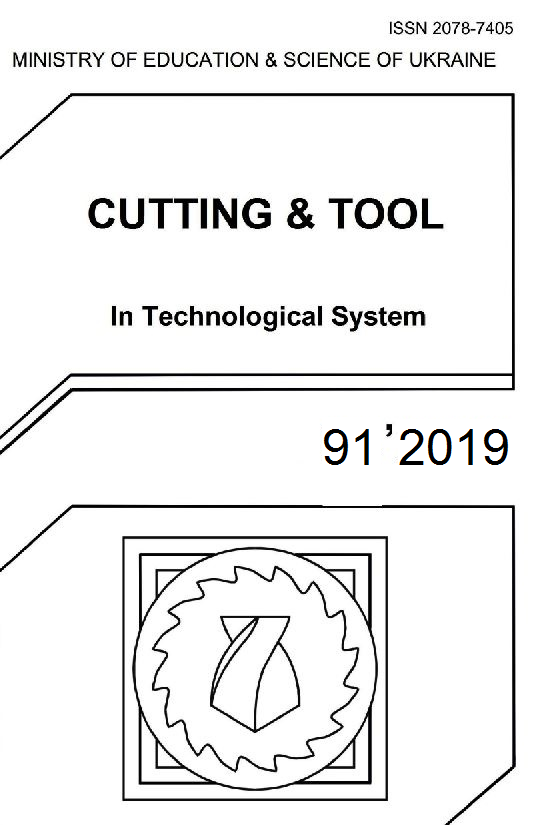INVESTIGATION OF SURFACE ROUGHNESS ON FACE MILLED PARTS WITH ROUND INSERT IN PLANES PARALLEL TO THE FEED AT VARIOUS CUTTING SPEEDS
DOI:
https://doi.org/10.20998/2078-7405.2019.91.09Keywords:
face milling, symmetrical milling, round insert, surface roughness.Abstract
In this paper, the roughness of the surface produced by symmetrical face milling is examined. During the research work, the effect of the use of a round milling insert on the surface topography was studied at different cutting speeds. 2D and 3D surface roughness measurements were carried out in three measurement planes parallel to the feed direction, one of them being the plane of symmetry and the other two planes being at the same distance from it, in both sides. From the analysis of results, it was found that surface roughness decreases significantly for cutting speed values over 100 m/min and then its variation is minimal. Furthermore, higher values of surface roughness are observed in the symmetric plane than the other parallel planes and almost in every case, surface roughness was found to be larger on the entry side plane than the exit side plane.References
Alharthi, N.H., Bingol, S., Abbas, A.T., Ragab, A.E., El-Danaf, E.A., Alharbi, H.F.: Optimizing cutting conditions and prediction of surface roughness in face milling of AZ61 using regression analysis and artificial neural network, Advances in Materials Science and Engineering, 7560468. (2017).
Subramanian, A.V.M., Nachimuthu, M.D.G, Cinnasamy, V.: Assessment of cutting force and surface roughness in LM6/SiCp using response surface methodology, Journal of Applied Research and Technology 15, pp. 283-296. (2017).
Ghoreishi, R., Roohi, A.H., Ghadikolaei, A.D.: Analysis of the influence of cutting parameters on surface roughness and cutting forces in high speed face milling of Al/SiC MMC, Materials Research Express 5(8), 086521. (2018).
Pathak, B.N., Sahoo, K.L., Mishra, M.: Effect of Machining Parameters on Cutting forces and surface roughness in Al-(1-2) Fe-1V-1Si Alloys, Materials and Manufacturing Processes 28(4), pp. 463-469. (2013).
Hernandez-Gonzalez, L.W., Perez-Rodriguez, R., Quesada-Estrada, A.M., Dumitrescu, L.: Effects of cutting parameters on surface roughness and hardness in milling of AISI 304 steel, Dyna 85(205), pp. 57-63. (2018).
Felhő, C., Karpuschewski, B., Kundrák, J.: Surface roughness modelling in face milling, Procedia CIRP 31, pp. 136-141. (2015).
Baek, D.K., Ko, T.J., Kim, H.S.: Optimization of feedrate in a face milling operation using a surface roughness model, International Journal of Machine Tools and Manufacture 41(3), pp. 451-462. (2001).
Muñoz-Escalona, P., Maropoulos, P.G.: A geometrical model for surface roughness prediction when face milling Al 7075-T7351 with square insert tools, Journal of Manufacturing Systems 36, pp. 216-223. (2015).
Zhenyu, S., Luning, L., Zhanqiang, L.: Influence of dynamic effects on surface roughness for face milling process, International Journal of Advanced Manufacturing Technology 80 (9-12), pp. 1823-1831. (2015).
Wang,R., Wang, B., Barber, G.C., Gu, J., Schall, J.D.: Models for prediction of surface roughness in a face milling process using triangular inserts, Lubricants 7(1), 9. (2019).
Pimenov, D.Yu., Bustillo, A., Mikolajczyk, T.: Artificial intelligence for automatic prediction of required surface roughness by monitoring wear on face mill teeth, Journal of Intelligent Manufacturing 29(5), pp. 1045-1061. (2018).
Bagci, E., Aykut, S.: Influence of symmetric and asymmetric machining strategies on surface roughness in face milling process of cobalt-based superalloy, Jounral of the Balkan Tribological Association 19(1), pp. 23-26. (2013).
Cui, X., Zhao, J.: Cutting performance of coated carbide tools in high-speed face milling of AISI H13 hardened steel, International Journal of Advanced Manufacturing Technology 71 (9-12), pp. 1811-1824. (2014).
Varga, G., Kundrák, J.: Effect of technological parameters on surface characteristics in face milling, Solid State Phenomena 261, pp. 285-292. (2017).
European Steel and Alloy Grades/Numbers, C45, http://www.steelnumber.com/en/steel_composition_eu.php?name_id=15/
Downloads
Published
Issue
Section
License
Copyright Notice
Authors who publish with this Collection agree to the following terms:
1. Authors retain copyright and grant the Collection right of first publication with the work simultaneously licensed under a Creative Commons Attribution License that allows others to share the work with an acknowledgement of the work's authorship and initial publication in this Collection.
2. Authors are able to enter into separate, additional contractual arrangements for the non-exclusive distribution of the Collection's published version of the work (e.g., post it to an institutional repository or publish it in a book), with an acknowledgement of its initial publication in this Collection.
3. Authors are permitted and encouraged to post their work online (e.g., in institutional repositories or on their website) prior to and during the submission process, as it can lead to productive exchanges, as well as earlier and greater citation of published work.

